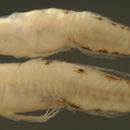en
names in breadcrumbs


Analogues: (heavy ventral markings)
Diagnosis: Modal fin-ray counts of D-VI,10 A-9 and Pect-15-17 with fused pelvic fins indicate Bathygobius curacao and Lythrypnus (and overlaps the range of Coryphopterus alloides). These genera typically have one fewer anal-fin ray than second-dorsal-fin rays. Larval Lythrypnus are lightly-marked and develop radiating bars of melanophores around the eye at transition. Coryphopterus also have lightly-marked larvae and C. alloides is the only species which would overlap this fin-ray count, although only rarely with 15 pectoral-fin rays. Lophogobius cyprinoides and Priolepis hipoliti share the median-fin ray count but have more pectoral-fin rays. Bathygobius are known for having the dorsal-most pectoral-fin rays separate from the rest and filamentous, however this feature is not apparent on larvae. This larval type has 15-17 pectoral-fin rays, indicating the species is B. curacao (B. soporator and B. mystacium have a mode of 19-20 pectoral-fin rays). (DNA) G14a
Description: Body relatively thin, long and narrow with a large eye and a terminal large mouth. Pectoral fins long, reaching to vent. Pelvic fins long, reaching almost to the vent, with an obvious pelvic frenum. Dorsal and anal-fin bases medium-length and caudal peduncle medium-length and sharply narrowing, 7-9 procurrent caudal-fin rays (7-8 spindly). Heavily marked; along the ventral midline there are large point, stellate, or streak melanophores at the isthmus, one or two forward of the pelvic-fin insertion, and a few behind the pelvic-fin insertion along the abdominal midline. Then there is a variable row of two or three large paired melanophores spaced along the anal-fin base, continuing as a row of three or four large single melanophores along the caudal peduncle ending at the start of the procurrent caudal-fin rays (the anal-fin base and caudal peduncle melanophores often merge into a single long streak). Dorsal markings consist of a row of paired melanophores on either side of the dorsal midline: a pair just forward of the spinous dorsal fin, one just behind, then two or three pairs spaced along the soft dorsal fin, followed by one to three unpaired melanophores along the dorsal midline of the caudal peduncle ending well before the start of the upper procurrent caudal-fin rays. Markings on the head consist of a large melanophore outlining the lower edge of the dentary at the tip of the lower jaw and another at the angle of the jaw (on pre-transitional larvae). Internal melanophores are present at the base of the braincase (sometimes around the upper braincase as well), at the sacculus, along the dorsal surface of the peritoneum and swim bladder, and continuing along the gut to the vent (often all of these merge into a dark streak arcing through the body). There is a row of internal vertebral melanophores above and usually below the vertebral bodies from the mid-body to the caudal peduncle. This streak can be prominent or mostly obscured by overlying musculature. Some individuals have melanophores at the base of the lower segmented caudal-fin rays extending out a short distance along the rays. Series of transitional larvae show development of the eye from round with dorsal and ventral indentations in the iris (mostly on the dorsal-anterior to ventral-posterior axis, but can vary) to fully round (most pre-transitional larvae captured have no indentations, and some transitional larvae have iris indentations). Transitional larvae intensify the surface melanophores on the iris (covering the upper third of the eyeball and at 2, 5 and 7-8 o'clock) and develop a stripe from the eye forward across the mid-upper jaw to the mid-lower jaw and a stripe of melanophores behind the eye across the mid-operculum. Transitional larvae then develop a speckling of large melanophores and leukophores on the top of the head to the base of the pectoral fin and a stripe of iridophores across the operculum and onto the base of the pectoral fin.